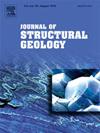Using 3D models to test geological hypotheses for sill complex geometries: Application to Jurassic dolerite intrusions, Tasmania
IF 2.9
2区 地球科学
Q2 GEOSCIENCES, MULTIDISCIPLINARY
引用次数: 0
Abstract
This study employs three-dimensional (3D) geological modelling to test competing hypotheses regarding the subsurface architecture of Jurassic dolerite sills in the Hobart region, Tasmania. Although this sill complex has been extensively studied, there is little subsurface data, making it an excellent case study for using 3D models to better understand its architecture. Four alternative models are built using the LoopStructural Python library, which incorporates rules from intrusion emplacement mechanisms into the modelling workflow. All four models are constrained using the same input dataset, comprising field measurements, most of which are located in the southwest part of the study area. The differences between the models are governed primarily by which pre-intrusion mechanical anisotropy facilitated emplacement of the dolerite. The models are visually and quantitatively compared with the published geological map of the area and with field observations. The results of this comparison suggest that northeast and northwest-trending outcrop patterns of the dolerite are likely related to the presence of transgressive sheets within sedimentary host rocks of the Permo-Triassic Parmeener Supergroup, and that the occurrence of dolerite sills at different stratigraphic and structural levels is likely due to a combination of primary intrusive steps and post-intrusion faults.
使用3D模型测试复杂几何形状的地质假设:应用于塔斯马尼亚侏罗纪白云岩侵入
本研究采用三维(3D)地质模型来测试有关塔斯马尼亚州霍巴特地区侏罗纪白云岩岩的地下结构的相互竞争的假设。尽管这个复杂的问题已经得到了广泛的研究,但地下数据很少,因此使用3D模型来更好地了解其结构是一个很好的案例研究。使用LoopStructural Python库构建了四个备选模型,该库将入侵放置机制中的规则合并到建模工作流中。所有四种模型都使用相同的输入数据集进行约束,这些数据集包括现场测量数据,其中大部分位于研究区域的西南部分。模型之间的差异主要是由于侵入前的力学各向异性促进了玄武岩的侵位。这些模型在视觉上和数量上与该地区已出版的地质图和实地观测结果进行了比较。研究结果表明,白云岩的东北向和西北向露头模式可能与二、三叠系Parmeener超群沉积寄主岩内海侵片层的存在有关,不同地层和构造水平的白云岩层位可能是由早期侵入台阶和侵入后断裂共同作用的结果。
本文章由计算机程序翻译,如有差异,请以英文原文为准。
求助全文
约1分钟内获得全文
求助全文
来源期刊

Journal of Structural Geology
地学-地球科学综合
CiteScore
6.00
自引率
19.40%
发文量
192
审稿时长
15.7 weeks
期刊介绍:
The Journal of Structural Geology publishes process-oriented investigations about structural geology using appropriate combinations of analog and digital field data, seismic reflection data, satellite-derived data, geometric analysis, kinematic analysis, laboratory experiments, computer visualizations, and analogue or numerical modelling on all scales. Contributions are encouraged to draw perspectives from rheology, rock mechanics, geophysics,metamorphism, sedimentology, petroleum geology, economic geology, geodynamics, planetary geology, tectonics and neotectonics to provide a more powerful understanding of deformation processes and systems. Given the visual nature of the discipline, supplementary materials that portray the data and analysis in 3-D or quasi 3-D manners, including the use of videos, and/or graphical abstracts can significantly strengthen the impact of contributions.
 求助内容:
求助内容: 应助结果提醒方式:
应助结果提醒方式:


